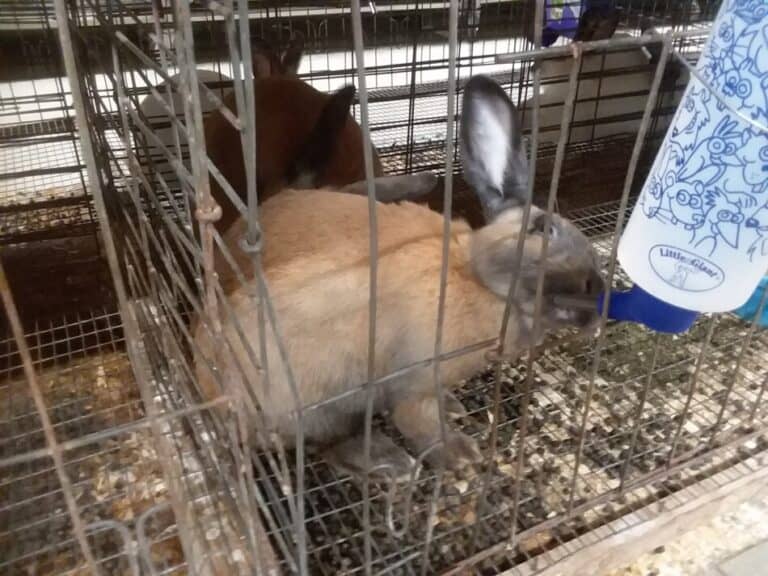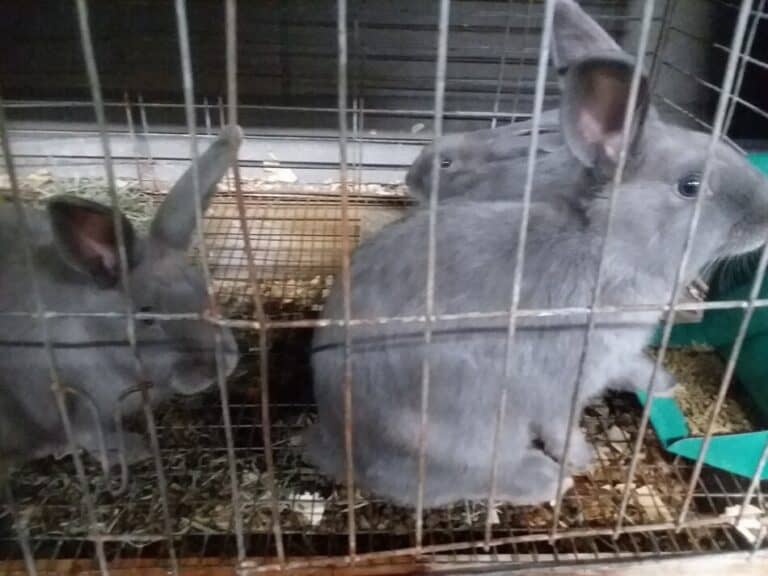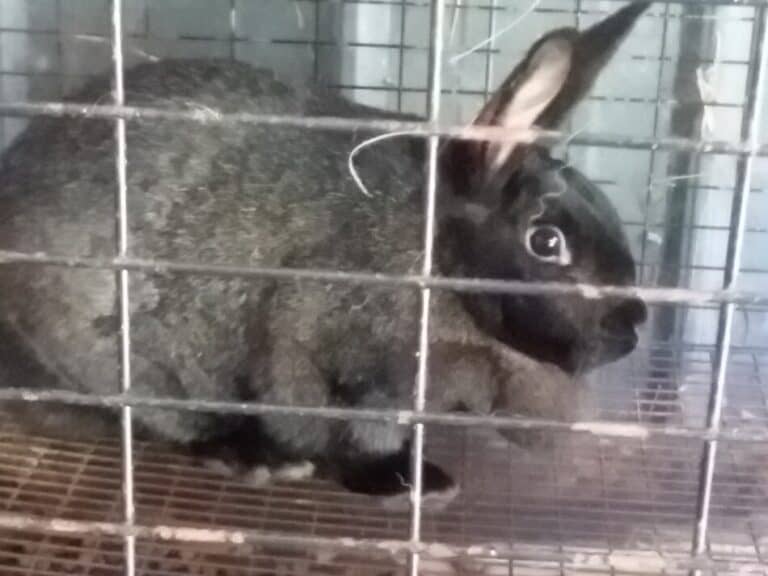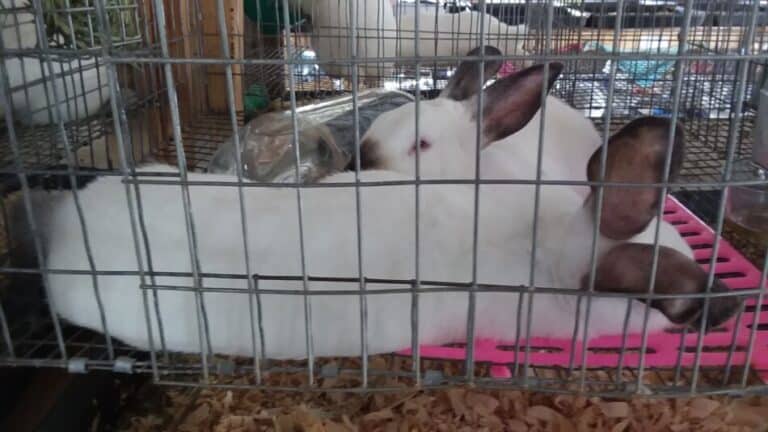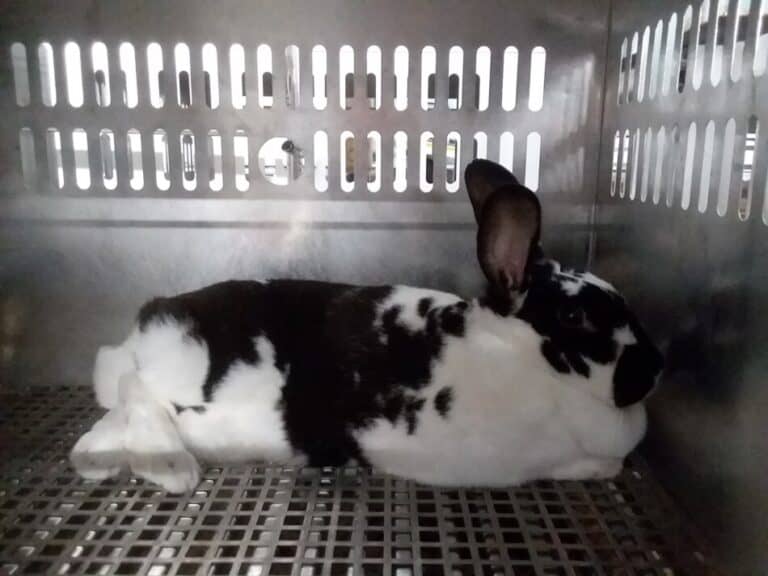How To Start Raising Rabbits For Meat
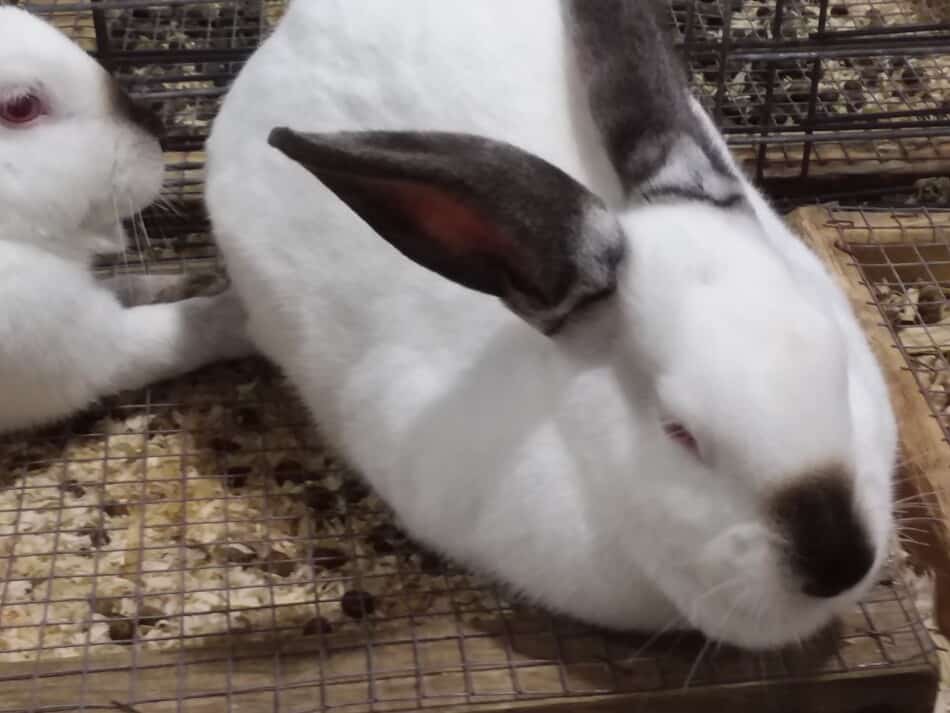
Getting started with meat rabbits? Wonderful choice! Rabbits are backyard superstars that are rising in popularity since they are quiet, only need a small amount of space and are family friendly. Here’s the things you’ll need to get started!
To raise rabbits for meat, you need appropriately sized cages (based on the size of the adult rabbits) and feeders, feed and waterers for each cage. You’ll need a 30″x30″ (minimum) cage per breeding age rabbit (commercial meat breeds) plus one cage per doe to be used as a grow out pen for the litter.
We’ll start with the less exciting stuff (cages and equipment) first, then move to the rabbits, themselves.
Amount Of Meat From A Pair Of Rabbits helps you calculate out what you can expect from your meat rabbits, based on how often you plan to breed the pair and litter size.
Have your pens and equipment ready before you buy rabbits
Have pens and equipment completely set up and ready to use before you bring home your rabbits.
Arrange to buy the rabbits, this way you’ll know the size of pens you’ll need, or just plan to buy rabbits that are suited to your set up, but either way be set up first.
Order or buy ahead of time and do not get your rabbits until your equipment is at your house. In the popular times of the year, supplies being on backorder is common, meaning you can have rabbits but nowhere to put them!
An appropriate set up for your rabbits includes shade and plentiful water. Rabbits need more water in the heat, when there are multiple rabbits in one pen and when they have a bowl (since they will get the water dirty).
Determining cage size for rabbits is an MSU Extension article showing appropriate cage sizes based on the adult weight of the rabbit.
Shaded pens are crucial to keeping rabbits comfortable
It’s easy to overlook changes in shaded areas that happen throughout the day. Make sure your rabbits have all day shade.
Sometimes a nice shady spot in the morning can be a real baker in the afternoon, not a good spot to keep your rabbits!
Shade is particularly important in the summer, rabbits tend to “feel the heat” much sooner than people and are very prone to heat stress.
It’s easier to keep the rabbits cooler to begin with by keeping them in the shade, than try to make them comfortable once the temperatures start to go up.
Have a feeder and waterer for each rabbit cage
You can use water bottles or water bowls for your rabbits, whichever works better for you. Have at least one of each per cage.
Both have pros and cons, water bottles are cleaner, but seem to provide less water. Bowls are easier for the rabbits to drink from, but get messy so have to be refilled.
Cages may need more than one feeder and/or waterer, especially if the litter is all housed together. That’s a lot of fryers (young weaned rabbits) for one water bottle!
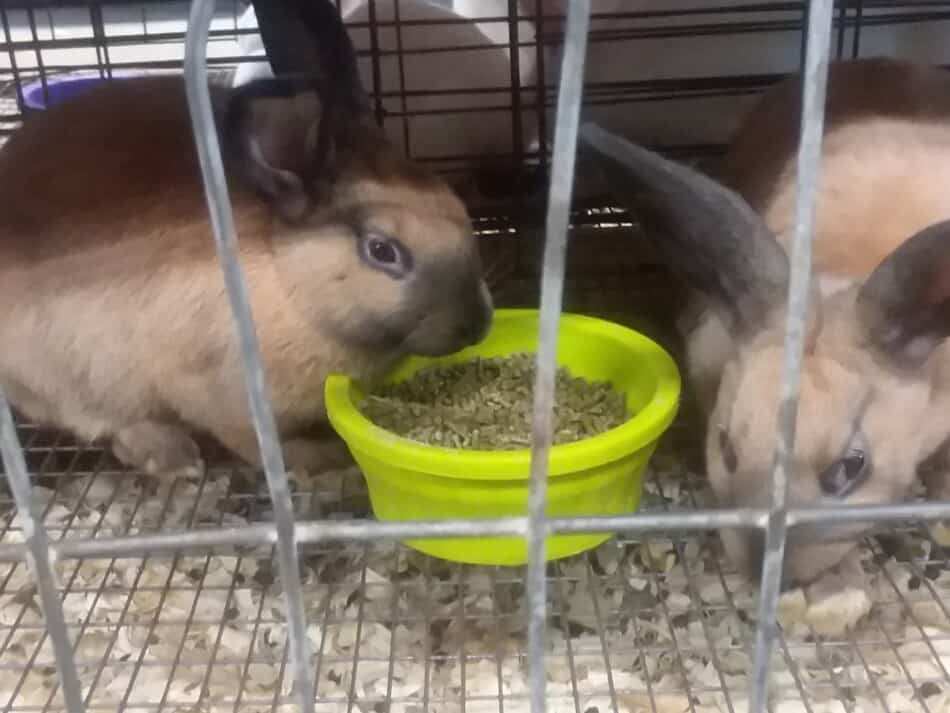
Use a J feeder for feed, rabbits spill bowls
Rabbits will spill feed, use a J feeder to minimize feed wasting. Feed bowls work, too, they will just end up pooped in or spilled, which wastes feed.
It can be tempting to use plastic containers for your rabbits, especially for feed. These will work until you can replace them, but since rabbits spill feed and chew plastic, you’ll need to replace and refill these often.
Honestly, it’s easier just to get the J feeder!
Determine how many rabbits you need
You need to figure out how many rabbits you really need, vs how many you want! Read How Many Meat Rabbits For A Family Of Four to get a start on your numbers.
All you need to know to make a decision on the number of rabbits to start with is how often you plan to eat rabbit and do a bit of thinking about the weather in your area to block out kindling times that are too extreme for your rabbits.
I have to admit, I am more of a “get some rabbits, then figure out what they will produce” kind of person. If you are okay with getting whatever you get, in terms of fryers for your freezer, the just do something plan is fine.
If you are more of a precisely minded person, or really want your rabbits to cover a specific amount of meals per week, you’ll need to spend a bit more time to see exactly how many breeding rabbits you should start with.
It is common to start with a breeding trio of rabbits
Most folks would start with a trio of breeding rabbits, one male and two females, but you can also go with an extended trio, which is one male and three females.
But, neither of these will tell you how many rabbits, actually how many fryers, you actually need.
Unless you are willing to be happy with whatever results you get, do the math first and get the number of rabbits to start out with that you need to get the results you want.
Buy high quality breeding stock rabbits
It can not be overstated, start with high quality breeding stock for your rabbit operation!
Get your breeding stock from someone who is raising rabbits for meat, keeping records and feeding their rabbits the way you plan to feed yours.
In order to find a breeder who is raising rabbits the way you plan to raise yours, you’ll have to have figured out how you want to operate your rabbit program.
Even if you are just planning to keep it relatively small, with a trio or so, you want to have a great trio that produces well, not so-so rabbits that will eat all your feed, but produce little in return!
Why waste your time with low producers? Start with great stock, they will grow better and perform better, overall. Meaning that the better rabbits will save you money compared to poor breeding stock, it’s all about the feed costs!
Know what high quality rabbits look like
How can you tell if you are looking at high quality breeding stock? First off, know what the breed should look like. Know what the adult weight ranges are and ask to see these rabbits on the scale to see their weight.
Ask the breeder about what specifically s/he is breeding for in this stock, width, higher litter numbers, and good attitude are just a few examples. A great breeder is working towards and will have an answer.
If, on the other hand, you ask what traits the owner is breeding for in the rabbits and the answer is “I just want more rabbits, or I didn’t get the litter separated out on time and this is an accidental breeding” those aren’t great answers.
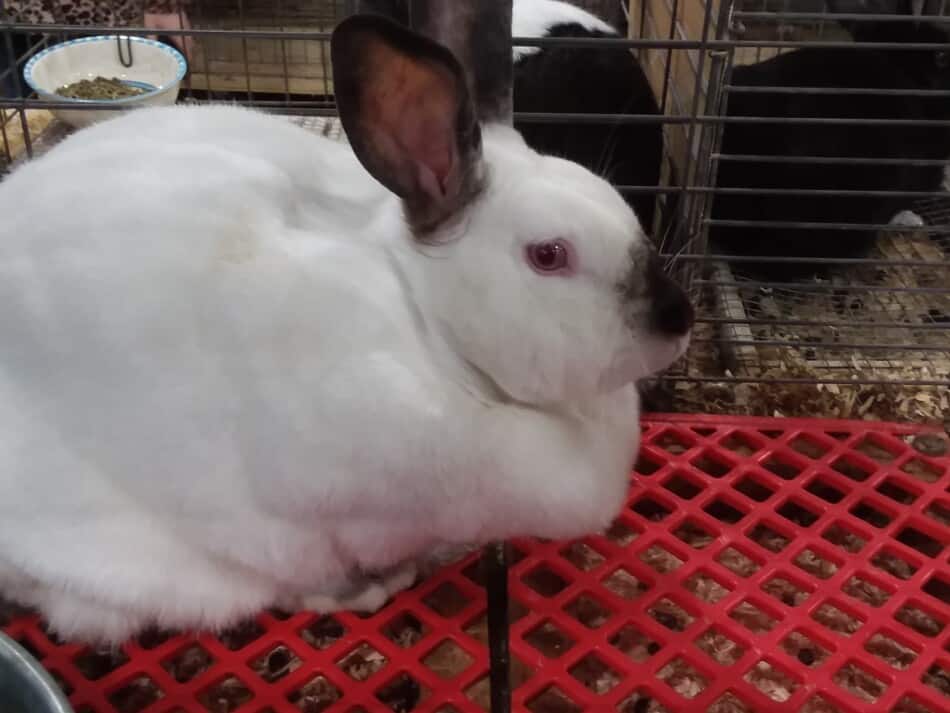
Don’t over complicate breed choice
Start with one of the main meat rabbit breeds, like New Zealand White and Californian. These breeds are popular, specifically the most popular, because they are superior choices for meat production. It’s really that simple.
I know there are a ton of other breed choices out there and if you are like me, you’d like some variety or color, but hold up! Think about your main purpose and don’t get distracted from the things that really matter!
Once you get a few years of rabbit raising in and decide you are into rabbits for the long haul, then consider a different breed if you want to branch out. As a beginner, start with NZW or Californian breeding stock.
Feed high quality pelleted feed
Get a high quality pelleted feed to start your rabbits on. In my experience, the cheaper priced store brand rabbit pellets are not well accepted by the rabbits, so I don’t buy them! (I made this mistake once, I won’t do it again!)
Go with a brand name feed, your rabbits will eat it better, so you’ll get more results, mainly growth, for your money.
Use the same feed that your breeder is feeding. If you want to transition your rabbits to a different type of feed, do so slowly, over the course of a few weeks. Rabbits have a sensitive digestive system, be cautious with changes in feeding.
Feeding hay or grass will slow growth
If you want the best growth from your fryers (weaned young rabbits), you’ll want to keep them eating pelleted feed only. You can give them grass or hay, if you want, but it will slow down their growth.
I have to admit, I like to give a small handful of hay (or greens if it’s summer)to the pen, just because they seem to like it.
However, rabbits are prone to digestive problems and feeding anything other than pellets can result in digestive upsets that can be hard to impossible to get your rabbits to recover from.
The other catch with feeding anything other than pelleted feed is that the other thing is most likely lower in protein than the growing fryers need, so you are actually giving the rabbits an overall lower protein diet than you think.
Adult rabbits can eat the hay and maintain weight well, younger rabbits need all the nutrition they can get and feeding lower quality feeds, like a not so great hay, lowers their intake of nutrients for the day, resulting in slower growth.
Pastured rabbits will grow more slowly than penned rabbits
Putting rabbits on pasture (in wire bottomed chicken tractors) will have them growing more slowly than rabbits that are in a pen, even though both sets of rabbits will generally have access to free choice pelleted feeds.
A few farmers, with years of specifically selected genetics, can grow rabbits on grass or other forages only (check out Forage Based Rabbits at Polyface) however, most rabbits you will be able to buy need the pellets to maintain growth.
Once again, this is because grass has a lot of volume for the nutrition, when compared to a pelleted feed. This will slow the growth of your fryers.
To be clear, if you want your rabbits on grass, go for it! I enjoy seeing rabbits eating grass and they seem to like it, however, know that you are slowing the growth, so these fryers will take longer to reach finishing weight.
For me, I’m raising rabbits to please myself, so if I like them on grass, then I have them on grass. If you are raising rabbits for a specific schedule or to sell, make sure the slower gains will work out for your needs.
Heat will slow rabbit growth
We often think of the middle of winter as the most difficult weather to be out in, maybe for us it is! But for rabbits, the most challenging time of the year is in the heat of the summer!
Just like you, when you are really hot, you don’t want to eat, you just want to lay around and wait for it to cool off outside! Your rabbits are the same way!
When the temperatures outside are hot for you in a T shirt, your rabbits are too hot to be eating. If they are not eating, they are not growing!
Have a plan to keep your rabbits cool during the hot weather
There are a few options to keep your rabbits as comfortable as possible, even in the heat of the summer.
First off, the easiest way to help your rabbits handle the warmer weather is shade. Rabbits naturally spend most of their time in a shaded, at least partially enclosed and safe area and just come out to eat. This makes them feel safe.
Rabbits are naturally predator magnets and being out in the open “just because” is a luxury reserved for something or someone that has little to no fear of a hawk swooping down and grabbing them!
Plus, if you notice there is less heat in a shaded or overgrown spot and definitely less heat underground.
The next step to increasing your rabbit’s comfort in the heat is to have air movement. This can be in an area that naturally gets a breeze or from setting up some fans.
Other things that you may not consider helpful to dealing with heat are having a clean pen, this keeps the manure smells from bothering your rabbits and increases ventilation from below.
Free choice water for rabbits is crucial in the heat
Of course, you give your rabbits free access to drinking water, but consider using water for cooling, specifically putting in a jug of frozen water or a crock of cool water for them to lay against.
If you have quite a few cages, putting in frozen bottles can be a chore! But overheating happens in rabbits sooner than in people, so getting a jump on the situation can reduce the stress in your rabbitry.
